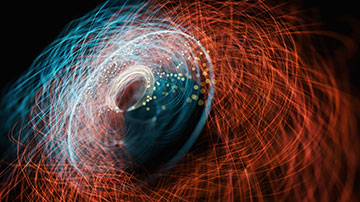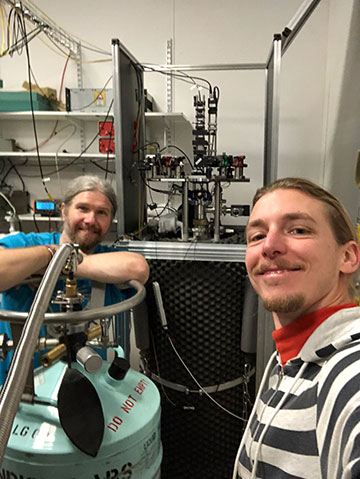
Research led by Mete Atatüre and Dorian Gangloff in collaboration with Austrian researchers has transferred quantum states back and forth between a single confined electron and 13,000 nuclei in a semiconductor quantum dot. [Image: koto_feja/ Getty Images]
Scientists in the United Kingdom and Austria have shown experimentally how the collective behavior of atomic nuclei in a semiconductor quantum dot could be used to store data in large-scale quantum networks (Nat. Phys., doi: 10.1038/s41567-024-02746-z). Having held quantum states in the nuclei for more than 100 microseconds and then read those states back out via an electron spin, the researchers are confident they can increase the memory's storage time to the point where it is useful for real-world systems.
Overcoming optical loss
Light-based quantum networks are being designed to improve on the security of classical communication through tamper-proof quantum keys and also to implement entirely new applications, such as distributed quantum computing and sensing. But sending quantum information via photons over long distances is complicated by the need to compensate against loss in optical fiber. Doing so with classical data is fairly trivial, requiring that signals simply be detected, amplified and retransmitted. Quantum data, however, are subject to the no-cloning theorem, which prevents copying of unknown quantum states.
In principle, quantum objects can be linked over arbitrarily long distances via entanglement. But optical loss remains a problem—it causes an exponential drop in signal strength with distance. The answer is to break down a link into shorter, lower-loss sections, entangling the ends of each section at intermediate nodes, then entangling neighboring sections at higher-level nodes, and so on until the whole distance is spanned. However, because no single act of entanglement is guaranteed to work the first time around, nodes must store entangled states until all other nodes have signaled that they are ready—a task that calls for quantum memory.
Researchers are currently working on a number of different memory technologies, often involving some kind of spin qubit acting as a middleman between the photons that transmit data and relatively long-lived nuclear states that serve as a quantum register. Such systems include diamond-vacancy centers linked to carbon-13 nuclear spins, for example, or different kinds of ions coupled together inside a crystal. Quantum dots made from group III-V semiconductors are also good candidates as registers because they have excellent photon coherence and brightness, but the thousands of nuclear spins that would form the memory tend to generate excessive noise for the electron spin qubit acting as the quantum go-between.
A quantum register
In the latest work, Mete Atatüre, Dorian Gangloff and colleagues at the University of Cambridge, UK, together with researchers at Johannes Kepler University, Austria, have shown how suitable engineering can overcome this problem and yield a quantum register with two collective states. The register creates a logical “zero” via what is known as a dark state, in which many entangled nuclei keep environmental interactions to a minimum, boosting coherence and stability. The complementary state “one” instead consists of a “magnon” excitation, in which the flipping of a single nuclear spin sets off a wave of spin flips throughout the register.

Researchers Mete Atatüre (left) and Dorian Gangloff [Image: Mete Atatüre and Dorian Gangloff]
Atatüre and coworkers built their proof-of-principle register using a quantum dot made from arsenic-75, gallium-69 and gallium-71. They embedded the quantum dot in a p-i-n diode, which yielded a stable spin qubit in the form of a single conduction-band electron confined to a volume consisting of 13,000 nuclei split 50:50 between the arsenic and the two forms of gallium. The team was able to limit noise from random fluctuations of the nuclear spin ensemble with feedback-induced spin flips.
The researchers showed that they could transfer quantum states from the electron spin qubit to the collective nuclear states and back again. They did this using a “SWAP” gate to map the electron spin’s superposition to a coherent superposition of the dark and magnon states. After holding that superposition in the register for a brief period, they used a second SWAP gate to perform the reverse mapping, at which point they measured the electron to establish whether or not its original quantum state had been preserved.
Quantum memory
The team then went a step further and showed how this scheme could be exploited in a quantum memory, performing full quantum gate tomography using the electron spin qubit’s six states—two spin orientations for each of the three orthogonal axes. Characterizing the 36 possible combinations of input and output states, Atatüre and colleagues found that they retrieved the original state in around seven out of every 10 trials—an average fidelity of 70%—while achieving a quantum information storage time of about 130 microseconds.
The researchers are taking part in a European project called MEEDGARD, coordinated by Gangloff, which aims to make quantum registers from gallium arsenide quantum dots with 90% fidelity and storage times of more than 100 milliseconds. The team says there are a number of ways it can work toward these milestones, including the use of narrower nuclear transitions through residual strain control, repeated inversion of the electron state to suppress the electron-induced magnetic field felt by the nuclei, eliminating the gallium-69 isotope, and introducing microwave control of the electron.
They add that, as well as aiding in the development of quantum memory, their research could yield new insights into collective phenomena, highlighting super-radiant nuclear spin dynamics, time-crystalline behavior and out-of-equilibrium many-body dynamics as three areas that stand to benefit.
